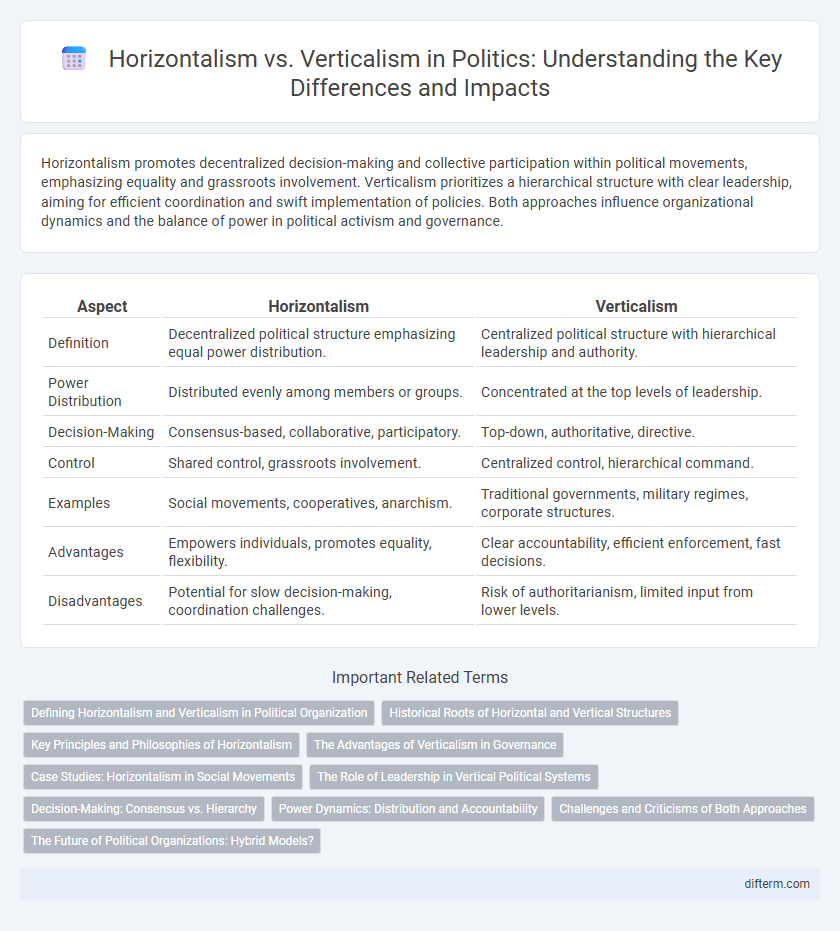Horizontalism promotes decentralized decision-making and collective participation within political movements, emphasizing equality and grassroots involvement. Verticalism prioritizes a hierarchical structure with clear leadership, aiming for efficient coordination and swift implementation of policies. Both approaches influence organizational dynamics and the balance of power in political activism and governance.
Table of Comparison
| Aspect | Horizontalism | Verticalism |
|---|---|---|
| Definition | Decentralized political structure emphasizing equal power distribution. | Centralized political structure with hierarchical leadership and authority. |
| Power Distribution | Distributed evenly among members or groups. | Concentrated at the top levels of leadership. |
| Decision-Making | Consensus-based, collaborative, participatory. | Top-down, authoritative, directive. |
| Control | Shared control, grassroots involvement. | Centralized control, hierarchical command. |
| Examples | Social movements, cooperatives, anarchism. | Traditional governments, military regimes, corporate structures. |
| Advantages | Empowers individuals, promotes equality, flexibility. | Clear accountability, efficient enforcement, fast decisions. |
| Disadvantages | Potential for slow decision-making, coordination challenges. | Risk of authoritarianism, limited input from lower levels. |
Defining Horizontalism and Verticalism in Political Organization
Horizontalism in political organization emphasizes decentralized decision-making, fostering equal participation and collective leadership among members. Verticalism relies on a hierarchical structure with clear authority lines and top-down directives to maintain control and coherence. Defining these approaches hinges on the balance between distributed power in horizontalism and centralized command in verticalism.
Historical Roots of Horizontal and Vertical Structures
Horizontalism traces its historical roots to early anarchist and socialist movements emphasizing direct democracy and decentralized power, as seen in the Spanish Revolution of 1936 and the Zapatista uprising in the 1990s. Verticalism originates from hierarchical political systems and authoritarian regimes where centralized authority ensures strict control, exemplified by monarchies and bureaucratic state socialism in the 20th century. These contrasting structures reflect enduring debates over power distribution, governance, and citizen participation in political history.
Key Principles and Philosophies of Horizontalism
Horizontalism emphasizes decentralized decision-making, direct participation, and egalitarian structures where power is distributed equally among members. It prioritizes consensus-building and grassroots organization over hierarchical authority, aiming to dismantle traditional power imbalances within political movements. Key principles include autonomy, collective responsibility, and rejection of centralized leadership to foster inclusive and democratic participation.
The Advantages of Verticalism in Governance
Verticalism in governance centralizes decision-making authority, allowing for streamlined policy implementation and consistent regulatory enforcement. This hierarchical structure enhances accountability by clearly delineating roles and responsibilities among government officials. Concentrated power in verticalism facilitates swift responses to crises and efficient coordination across multiple levels of government.
Case Studies: Horizontalism in Social Movements
Horizontalism in social movements emphasizes decentralized decision-making, as exemplified by the 2011 Spanish Indignados and the Occupy Wall Street protests, where leaderless structures fostered inclusivity and collective action. This approach contrasts with verticalism, highlighting grassroots participation without hierarchical control, often leading to enhanced mobilization and adaptability. Case studies reveal that horizontalism challenges traditional political organization, promoting democratic engagement and decentralized power distribution.
The Role of Leadership in Vertical Political Systems
Leadership in vertical political systems centralizes authority within a hierarchical structure, where decision-making flows from top-tier officials to lower levels. Such leadership emphasizes control, discipline, and clear chain of command to maintain order and enforce policies. The effectiveness of vertical political leadership often depends on the leader's ability to balance power consolidation with responsiveness to subordinates' needs.
Decision-Making: Consensus vs. Hierarchy
Horizontalism promotes decision-making through consensus, emphasizing equal participation and collective agreement among members, which fosters inclusivity and shared responsibility. Verticalism relies on hierarchical structures where decisions are made by leaders or designated authorities, streamlining processes but potentially limiting diverse input. The balance between horizontal consensus and vertical hierarchy shapes political organizations' responsiveness and adaptability.
Power Dynamics: Distribution and Accountability
Horizontalism emphasizes decentralized power distribution, promoting collective decision-making and shared accountability among groups or communities. Verticalism concentrates authority within hierarchical structures, facilitating streamlined decision processes but increasing risks of power concentration and reduced transparency. Power dynamics in political systems hinge on balancing these models to ensure both effective governance and accountable leadership.
Challenges and Criticisms of Both Approaches
Horizontalism faces challenges such as decision-making inefficiencies and lack of clear leadership, which can hinder timely policy implementation. Verticalism often encounters criticisms related to authoritarianism, limited grassroots participation, and potential disconnect from local needs. Both approaches struggle to balance inclusivity with effective governance, impacting political stability and responsiveness.
The Future of Political Organizations: Hybrid Models?
Hybrid political organizations combine horizontalism's decentralized decision-making with verticalism's structured leadership to balance inclusivity and efficiency. These models leverage horizontal networks for grassroots mobilization while employing vertical hierarchies to navigate complex policy environments and ensure accountability. Emerging trends suggest hybrid structures can enhance political adaptability and resilience in dynamic sociopolitical landscapes.
horizontalism vs verticalism Infographic

 difterm.com
difterm.com